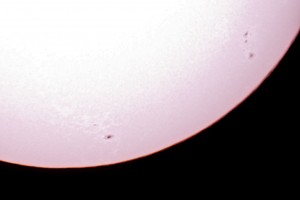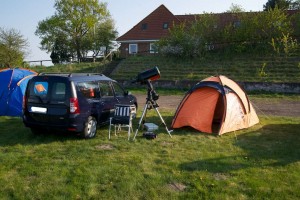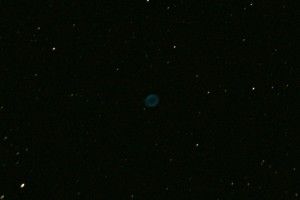After a few chores in the morning, I’m off to the Aschberg Frühjahrs Teleskoptreffen. My new car enables me to actually carry my new equipment; my old Daihatsu Mira would not have had the space. To pack: telescope with accessories, tent, camping equipment for three days, lots of warm clothes, photography equipment. Everything goes in without having to stack things. Not a bad thing, such a Dacia.
After only a short traffic jam I arrive on the Aschberg, around 4:30 pm. Unlike the previous years, the field is already pretty full, but the place I had planned on setting up in — close to the youth hostel and where the electricity is — is sufficiently empty. I park so that there is enough space between my car and the next to set up my tent and ‘scope. Setting up the tent is not exactly easy; there is a very strong and gusty wind. After having put the struts through the tent, I quite literally take off, holding on to the tent which wants to go elsewhere. After a serious struggle to prevent scratches and dents in the neighbouring cars that lasts almost a full minute, I can finally force it back to the ground and hurry to nail it down, not without hefty opposition by the wind. The sky is remarkably clear though.
Now to set up the telescope. The loading doors of my car are repeatedly forced shut by the wind. I align the mount using a compass lying on the tripod. After finishing setting up, I go to register and pay my fees. and to ask for some sticky tape to prevent my sun filter from going a-flying. I get the tape, tape the filter to the tube, and find out why my last few attempts at aligning the mount were less than satisfactory: for some reason, the mount had remembered the co-ordinates of the Aschberg. When I wanted to put in the co-ordinates, they were already correct. Since this location is almost on the same latitude as Luebeck, I probably just checked on the latitude setting, found it correct, and did not check the longitude setting. Mental note: always check everything to the last decimal place in the future. Date, time, then aligned using the sun as a reference after having put on an UV/IR blocker, damping filter and H-beta. Took a little effort to get the mount northbound, but then went for the sun and on the very first look, sunspots! And with the H-beta filter, the granulation of the sun’s surface can be made out really well.
 Time to make a round to see who and what else is attending. Many old acquaintances from previous meetings, but also a good number of newbies, both people and hardware. As opposed to the previous two AFT meetings, this time I dare to talk to people and learn many interesting things concerning telescopes, mounts and photography. Back to my own equipment; my tent neighbours, who had been away while I was setting up, are back; conversation happens. Statistics from the walkabout: the usual suspects are there; several Danes, apart from that mostly northern Germans. Bremen, Bremerhaven, Emden, Ostfriesland, Luebeck, Itzehoe, Hamburg… meanwhile, a Fiat transporter materialises next to me, containing three young people from around Itzehoe. They are here for the first time, and the first words I hear from their direction are “Shit, we just had to set up next to that fat one, didn’t we?” That refers to my C11; the group has a C8, which is quite an impressive telescope by itself. Of course, standing right next to its big brother, that impression is somewhat undermined. After an engaged conversation, I walk off to take pictures of the battlefield.
Time to make a round to see who and what else is attending. Many old acquaintances from previous meetings, but also a good number of newbies, both people and hardware. As opposed to the previous two AFT meetings, this time I dare to talk to people and learn many interesting things concerning telescopes, mounts and photography. Back to my own equipment; my tent neighbours, who had been away while I was setting up, are back; conversation happens. Statistics from the walkabout: the usual suspects are there; several Danes, apart from that mostly northern Germans. Bremen, Bremerhaven, Emden, Ostfriesland, Luebeck, Itzehoe, Hamburg… meanwhile, a Fiat transporter materialises next to me, containing three young people from around Itzehoe. They are here for the first time, and the first words I hear from their direction are “Shit, we just had to set up next to that fat one, didn’t we?” That refers to my C11; the group has a C8, which is quite an impressive telescope by itself. Of course, standing right next to its big brother, that impression is somewhat undermined. After an engaged conversation, I walk off to take pictures of the battlefield.
 Back to my base, I try to use the photographic setup of my new optics package for the first time. In order: C11 Schmidt-Cassegrain with TS Crayford focuser with reducer gear, then a coma corrector/field reducer/field flattener developed specifically for the C11 (so it would be useless for any other ‘scope), then the hull of an off-axis guider; since the guider piece of this cannot be fixed (the hex socket screw that is supposed to do that requires such a ridiculously small hex key that I have not managed to find one so far) I simply leave it out and accept the stray light coming in through the opening. It is well possible to take pictures of the sun; the quality of the pictures cannot compete with a PST, but here and there details can be made out. Sightseers come and go, also some seriously interested people; lots of ideas are exchanged. A few pictures are taken.
Back to my base, I try to use the photographic setup of my new optics package for the first time. In order: C11 Schmidt-Cassegrain with TS Crayford focuser with reducer gear, then a coma corrector/field reducer/field flattener developed specifically for the C11 (so it would be useless for any other ‘scope), then the hull of an off-axis guider; since the guider piece of this cannot be fixed (the hex socket screw that is supposed to do that requires such a ridiculously small hex key that I have not managed to find one so far) I simply leave it out and accept the stray light coming in through the opening. It is well possible to take pictures of the sun; the quality of the pictures cannot compete with a PST, but here and there details can be made out. Sightseers come and go, also some seriously interested people; lots of ideas are exchanged. A few pictures are taken.
The Aschberg is a popular day trip location; occasionally a confused hiker comes by and asks what is going on on the former sports field. I always try to talk these people into taking a tour of the field and talk to as many people as possible. That works pretty well most of the time. The wind, however, remains hefty; it bends and rattles my tent and tries to do the same to my telescope. At the far edge of the field, the CEO of the ASL arrives and starts setting up. I walk over and we talk for a bit. Meanwhile, it is getting noticeably colder, and throughout the evening, the amount of layers of clothes rises from two to five. Also, I change into winter boots.
 At nightfall I finally align my ‘scope, using three stars for calibration. Then I want to change to Saturn and am so completely off… so, from the beginning. Co-ordinates: correct. Date and time: not quite correct. Only most of a month off. Correct date put in and everything fits. I try to take pictures of Saturn using my webcam. Because of the focal length and the strong wind I do not have even the slightest chance of getting a clear picture. So I try with the Alpha900. That, however, is also hopeless. I stick with Saturn for a bit; some others also look through my tube.
At nightfall I finally align my ‘scope, using three stars for calibration. Then I want to change to Saturn and am so completely off… so, from the beginning. Co-ordinates: correct. Date and time: not quite correct. Only most of a month off. Correct date put in and everything fits. I try to take pictures of Saturn using my webcam. Because of the focal length and the strong wind I do not have even the slightest chance of getting a clear picture. So I try with the Alpha900. That, however, is also hopeless. I stick with Saturn for a bit; some others also look through my tube.
Just before midnight, I walk over to my clubmate; he is currently photographing star fields. I am just about to go when the cry comes up: “Northern lights!” I run to get my camera, but by the time I am back, the fireworks are already over. Only the quiet arc remains for a while longer, and I can take a picture. Not a spectacular view, but at least my first picture of an aurora, with the added benefit of the Milky Way being just barely visible in the picture. The seeing is practically perfect tonight.
Back at my optical bin, I go for M57, the Ring Nebula, which is very nicely visible optically. Then I switch to Vega to use my Bahtinov mask for the first time. I focus my camera through the viewfinder, put the mask on the tube and expose for eight seconds. Then I grumble about the result; I had focused practically perfectly by eye only. So I aim for M 57 again and try to get a few long exposures. After four attempts I realise that it is overly optimistic to hope for a good, undistorted exposure of two minutes. I set the automatic remote to 30 shots at 30 seconds each and let the camera do its magic. For a bit, I stand around and watch the sky; a few shooting stars are visible, as well as one fireball. Then I walk over to the hostel to warm up and rest for a bit. After one hour, I go back out and use the same settings on M56, a globular cluster. The processing of the pictures has to wait until I am back home. It will turn out that I got a picture in which the Ring nebula is at least recognisable, though not spectacular, and the pictures of M56 are completely unusable because I did not get a single exposure that was not wiggled, despite the wind ebbing off.
In the meantime we are nearing sunrise; the northeastern sky is getting noticeably brighter. I drink one last beer, stow what there is to be stowed, set my mount to zero position (that way, I do not have to re-align tomorrow…) and vanish into my tent.


